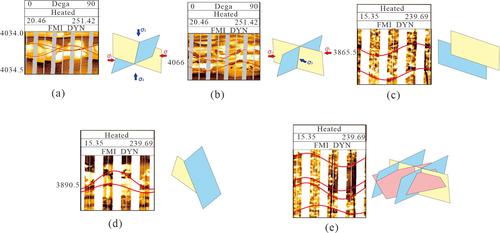当前位置:
X-MOL 学术
›
Acta Geol. Sinica Engl. Ed.
›
论文详情
Our official English website, www.x-mol.net, welcomes your feedback! (Note: you will need to create a separate account there.)
Genesis and Characteristics of Miocene Deep‐water Clastic Rocks in Yinggehai and Qiongdongnan Basins, Northern South China Sea
Acta Geologica Sinica-English Edition ( IF 3.3 ) Pub Date : 2021-01-08 , DOI: 10.1111/1755-6724.14637 Caiwei FAN 1 , Changgui XU 1 , Jie XU 2
Acta Geologica Sinica-English Edition ( IF 3.3 ) Pub Date : 2021-01-08 , DOI: 10.1111/1755-6724.14637 Caiwei FAN 1 , Changgui XU 1 , Jie XU 2
Affiliation

|
Various deep‐water deposits developed in the Yinggehai Basin and Qiongdongnan Basin (Ying‐Qiong Basin) in the northern South China Sea, making the two basins significantly hydrocarbon‐producing areas and ideal for studying the genetic mechanism and sedimentary characteristics of deep‐water clastic rocks. Using cores, image well logging, heavy mineral assemblages, and seismic data, we thoroughly studied the geometry, tectonic background, driving mechanism, and source‐to‐sink process of deep‐water deposits in the study area. The results showed that: (1) there were five genetic mechanisms of deep‐water clastic rock, i.e., slides, slumps, debris flows, turbidity currents, and bottom currents. (2) The sliding deposits were distributed from the delta front to the continental slope toe. The slumping deposits were mainly distributed at the continental slope toe or the basin's central area, far from the delta front. The turbidity deposits were widely developed in the deep‐water area, but with huge differences in thickness. The bottom currents mainly reworked previous deposits far from the slope. (3) Slip and extension along the preexisting fault zone were the main structural factors that drive the axial channel formation at the slope foot. (4) The sand‐rich gravity sediment flows in the Ying‐Qiong basin were primarily caused by the direct supply of terrigenous debris into the marine environment over the slope break.
中文翻译:

南海北部莺歌海-琼东南盆地中新世深水碎屑岩成因与特征
南海北部的莺歌海盆地和琼东南盆地(莺琼盆地)发育了各种深水沉积,使这两个盆地成为重要的生烃区,是研究深水碎屑成因机制和沉积特征的理想选择岩石。利用岩心,图像测井,重矿物组合和地震数据,我们深入研究了研究区深水沉积物的几何形状,构造背景,驱动机制以及源-汇过程。结果表明:(1)深水碎屑岩有五种成因机制,即滑移,塌陷,泥石流,浊流和底流。(2)滑积物从三角洲前缘分布到大陆坡脚趾。塌陷的沉积物主要分布在大陆斜坡脚趾或盆地中心区域,远离三角洲前缘。浊度沉积物在深水区广泛发育,但厚度差异很大。底流主要是对远离斜坡的先前沉积物进行了改造。(3)沿既有断层带的滑动和伸展是驱动斜坡脚轴向通道形成的主要结构因素。(4)颖琼盆地富砂重力沉积物的流动主要是由于在坡折带上将陆源碎屑直接供应到海洋环境中引起的。底流主要是对远离斜坡的先前沉积物进行了改造。(3)沿既有断层带的滑动和伸展是驱动斜坡脚轴向通道形成的主要结构因素。(4)颖琼盆地富砂重力沉积物的流动主要是由于在坡折带上将陆源碎屑直接供应到海洋环境中引起的。底流主要是对远离斜坡的先前沉积物进行了改造。(3)沿既有断层带的滑动和伸展是驱动斜坡脚轴向通道形成的主要结构因素。(4)颖琼盆地富砂重力沉积物的流动主要是由于在坡折带上将陆源碎屑直接供应到海洋环境中引起的。
更新日期:2021-02-22
中文翻译:

南海北部莺歌海-琼东南盆地中新世深水碎屑岩成因与特征
南海北部的莺歌海盆地和琼东南盆地(莺琼盆地)发育了各种深水沉积,使这两个盆地成为重要的生烃区,是研究深水碎屑成因机制和沉积特征的理想选择岩石。利用岩心,图像测井,重矿物组合和地震数据,我们深入研究了研究区深水沉积物的几何形状,构造背景,驱动机制以及源-汇过程。结果表明:(1)深水碎屑岩有五种成因机制,即滑移,塌陷,泥石流,浊流和底流。(2)滑积物从三角洲前缘分布到大陆坡脚趾。塌陷的沉积物主要分布在大陆斜坡脚趾或盆地中心区域,远离三角洲前缘。浊度沉积物在深水区广泛发育,但厚度差异很大。底流主要是对远离斜坡的先前沉积物进行了改造。(3)沿既有断层带的滑动和伸展是驱动斜坡脚轴向通道形成的主要结构因素。(4)颖琼盆地富砂重力沉积物的流动主要是由于在坡折带上将陆源碎屑直接供应到海洋环境中引起的。底流主要是对远离斜坡的先前沉积物进行了改造。(3)沿既有断层带的滑动和伸展是驱动斜坡脚轴向通道形成的主要结构因素。(4)颖琼盆地富砂重力沉积物的流动主要是由于在坡折带上将陆源碎屑直接供应到海洋环境中引起的。底流主要是对远离斜坡的先前沉积物进行了改造。(3)沿既有断层带的滑动和伸展是驱动斜坡脚轴向通道形成的主要结构因素。(4)颖琼盆地富砂重力沉积物的流动主要是由于在坡折带上将陆源碎屑直接供应到海洋环境中引起的。



























 京公网安备 11010802027423号
京公网安备 11010802027423号